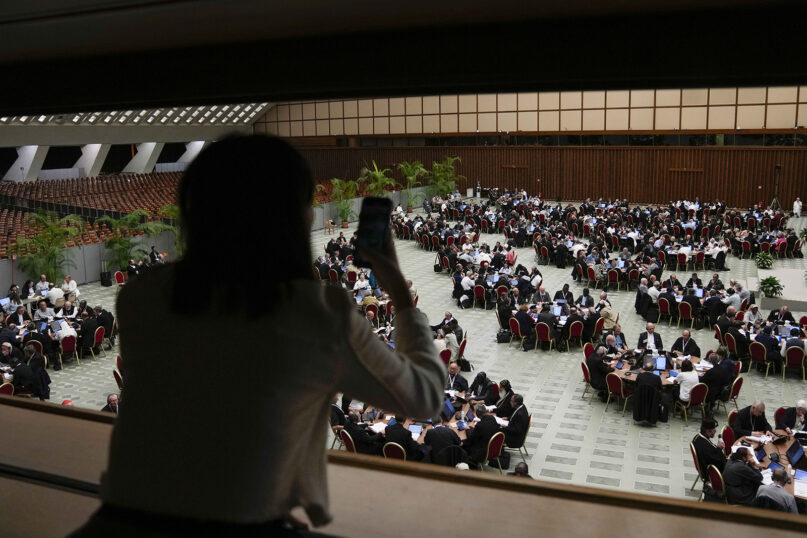VATICAN CITY (RNS) — The first rule of the Synod on Synodality: Don’t talk about the Synod on Synodality.
The long-awaited monthlong summit of Catholic cardinals, bishops, priests and laypeople called by Pope Francis to address the biggest challenges facing the church has been wrapped in a veil of silence or — as the pope calls his gag order on participants — “fasting” from discussing what is going on inside the plenary sessions and small groups at the Vatican.
In his inaugural address to the 364 synod participants and the theologians and other experts on hand to guide them, Francis called for “a certain type of fasting of the public word” to protect the spiritual conversations that he hopes will overcome the church’s polarization.
Francis later declared that “the church is taking a break” so it can turn its gaze inward to resolve the issues it faces.
What little has been said, even from the synod’s most vociferous critics, has been muted. On Thursday (Oct. 5), a former Vatican doctrine czar, Cardinal Gerhard Müller, spoke briefly about the synod to EWTN, the conservative Catholic news network based in the United States, saying only, “The experience at the table was very good, therefore I have some form of optimism,” and adding that the end will be determined by “the decisions behind the scenes.”
Francis’ decision to put a lid on the synod came at the last minute before it convened, surprising the church’s public relations officials, who were left with the impossible task of putting a positive spin on a secret synod.
“An institution as large as the church is giving itself a moment for common discernment in silence, listening, faith and prayer,” said Paolo Ruffini, who heads the Vatican’s communications department, during a briefing to journalists Thursday.
Part of the pope’s motivation may be to give the synod’s participants a safe space to express themselves on delicate topics put before them by Catholics in parishes around the world, who contributed to drafting questions for the synod. Those topics range from sexuality and LGBTQ inclusion in the church to female ordination and priestly formation, accountability for sexual abuse and reform of power structures in the church.
According to the Rev. David McCallum, executive director of the church’s Discerning Leadership program and one of the guides at the synod, the pope’s “boundary” on speaking outside the synod protects the participants “from influences that would in some way, shape or form, coopt the conversation or try to influence it ideologically.”
By closing the doors to the synod hall, McCallum added, the pope ensured that small interest groups cannot interfere. But the Jesuit priest admitted that it comes at a price. “When people don’t get information, they either assume the worst or create completely ungrounded expectations,” he said.
There are risks, of course, no matter which course the Vatican press office goes. Previous synods under Francis have been hijacked by public opinion and the media’s tendency to focus on hot-button issues such as married priests or allowing Communion for divorced and remarried Catholics. But shutting the doors can also backfire, allowing radicals to grab attention, such as when a right-wing activist tossed a sacred Amazonian image into the Tiber River during the 2019 synod on the Amazon region.
The official rules of the synod mandate that “each of the Participants is bound to confidentiality and discretion regarding both their own interventions and the interventions of other Participants.” So far, the rule has proved effective, without having to apply a formal ban known as pontifical secrecy on the gathering, which would allow violators to be excommunicated.
Ruffini clarified that the rule of discretion is encouraged, but those who blab should not fear that Vatican police officers will come knocking at their door if they violate it.
But obeying the pope’s request and staying mum has become a way of signaling allegiance to Francis and the synod process itself. One week into the synod, the debates and side chatter that could be heard in the days leading to the event have fallen silent. The host of Catholic commentators, activists and intellectuals in the Eternal City continue to gossip, and occasionally some of what is being discussed in the “circoli minori,” the small working groups at the synod, leaks out off the record. But real news is in short supply and the newspapers have little to report.
But the synod has yet to gather momentum, with substantive debates — particularly the question of how much LGBTQ Catholics should be welcomed in the church — only just starting, some participants told Religion News Service. The topic of women’s ordination and the female diaconate has yet to come up in earnest.
Not only the content of the debates but the format is unfamiliar to Catholic prelates, who are used to having the final word, usually in private, and sharing only what they wish. As Müller noted in his interview with EWTN, “the nature of the synod has changed,” with laypeople being allowed to have a decisive vote on the future of the church.
But change is also happening inside the synod itself, with new ideas and positions being heard as the process gets underway, participants said.
“It’s messy and complicated,” said McCallum, who added that the summit “feels like a sacred space, at the table, during the liturgies, and even at the line for coffee.”





